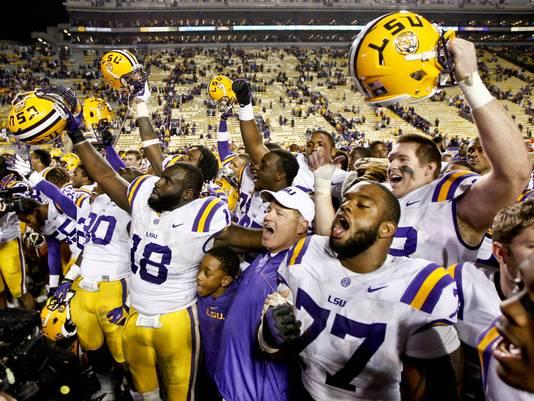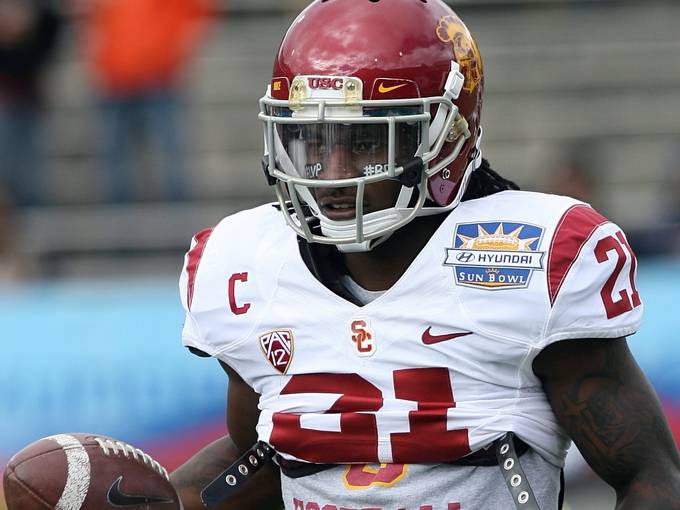BATON ROUGE — LSU coach Les Miles did not suddenly become a mean guy for whom no one wants to play.
Instead, a perfect storm of talented third- and fourth-year juniors and the new collective bargaining agreement in the NFL led to a LSU-record 10 underclassmen on the 2012 team entering the 2013 NFL draft over the past two weeks. It may be a record for any school in a single season.
“I like the fact that we send guys to the NFL early and recruit guys with the potential to go to the NFL early,” Miles said last week. “I want every guy that I recruit to have the opportunity to play a long, extended career in the NFL. I’d like to develop them.”
EVEN THE INJURED: LSU’s Faulk enters after lost season[1]
Miles has been one of the nation’s best recruiters since coming to LSU in 2005. He signed his highest-ranked classes ever in 2009 and 2010, and those players make up his 2012 junior class. Rivals.com ranked those two classes No. 2 and No. 6 nationally. They included a bevy of stars who helped lead LSU to a 34-6 record the past three seasons with a 13-1 record, a Southeastern Conference championship and a Bowl Championship Series title game appearance a year ago.
The 2009 class included defensive tackle Michael Brockers and cornerback Morris Claiborne, who were selected in the first round of the 2012 draft as juniors, and wide receiver Rueben Randle, who was drafted in the second round last year. Others who became starters and/or major contributors were defensive ends Barkevious Mingo and Sam Montgomery, offensive tackle Chris Faulk, defensive tackle Bennie Logan, middle linebacker Kevin Minter, safety Craig Loston, tailback Michael Ford, offensive guard Josh Williford and defensive tackle Josh Downs.
These hot-shot classes are nothing new for Miles. His 2006 class was ranked seventh, ’07 class fourth and ’08 class 11th by Rivals. That wealth of talent allows him to redshirt even highly regarded recruits, such as Mingo and Montgomery. Both players project to be high draft picks, with Mingo slotted in the top 10 and Montgomery the top 20, according to NFL Draft Report’s Mike Detillier. Faulk, who may have been a first-round pick before a knee injury ended his season after one game, Logan, a possible first-rounder, and lower-round prospects Minter and Ford also redshirted as freshman in 2009.
“There is no one reason,” Ford said. “Ever since I was a kid, I wanted to be in the NFL. I feel like my best chance to get in the league is now. I feel like I’ve maximized my potential at LSU.”
PHOTOS: Underclassmen declaring for NFL draft
Loston, who received a medical redshirt for the ’09 season, and Williford, who was redshirted, are rarities from the ’09 class. They are starters or regular contributors who will return for their senior season along with outside linebackers Lamin Barrow and Tahj Jones. Downs never redshirted and has finished his eligibility.
The 2010 signing class included another array of stars that would enter the 2013 NFL Draft a year early: cornerback/returner Tyrann Mathieu, safety Eric Reid, tailback Spencer Ware, punter Brad Wing and cornerback Tharold Simon. Mathieu would bring LSU’s early exodus total to 11, but he did not play on the 2012 team as he was dismissed from the program on Aug. 10 for repeatedly failing drug tests for marijuana. The Heisman Trophy finalist in 2011 could go in the second or third round, Detillier said.
Detillier has Reid going late in the first round, Ware in the third or fourth, Wing in the fifth and Simon in the third with an outside shot at the second.
So the only starters and/or regular contributors from the 2010 class who will return as fourth-year seniors in 2013 are tailback Alfred Blue, wide receiver Kadron Boone, fullback J.C. Copeland, wide receiver James Wright and tight end Travis Dickson. Blue missed most of the season with an injury. Boone, Wright and Dickson have not yet put up very good numbers. Quarterback Zach Mettenberger will return for his senior season, but he was a 2011 signee as a junior college transfer.
“I think this signifies that LSU is good at developing players and getting them ready for the NFL,” ESPN college football analyst Rece Davis said on a teleconference last week. “There is some great talent whose time to move on has come. It’s a good problem to have. The last thing you want is to have a bunch of seniors coming back who aren’t very good players.”
What is different about LSU’s early entrants is that of the 10, six could go in the third round or later: Minter, Simon, Ware, Faulk, Ford and Wing. And that is according to the evaluation reports provided to each player by the NFL. LSU players leaving despite low projections has upset fans and critics.
“Some of these LSU guys leaving are ready for the NFL,” analyst Joey Galloway said on ESPN last week. “Some of these guys are clearly not ready for the NFL.”
But LSU is not the only school with such middle-round jumps. San Diego State junior tight end Gavin Escobar entered the draft last week with his NFL evaluation saying third round. Tennessee quarterback Tyler Bray also has a low projection despite his early entry.
LSU has the most underclassmen from one school to declare this year with 10. Florida and Tennessee are a distant second with four, but the movement is spreading. As of Saturday, a record 67 underclassmen had declared for the 2013 NFL Draft. The previous record set last year was 65, which broke the record of 58 set in 2011.
“This year there will be more than 70 when it’s all over,” Detillier said. The deadline is Tuesday.
The NFL’s new collective bargaining agreement, which was signed in 2011, cut into the gap in pay for rookies drafted in the top rounds and lower rounds. That has created more reason to jump even when a player’s draft stock could be improved with another season.
“More and more you are going to see middle-round juniors entering the draft because of the new pay scale from the new CBA,” Detillier said. “As a third or fourth round pick, you can make between $350,000 to $500,000 with a signing bonus. And it’s not worth it financially to stay another year in college to go up a round because the money is about the same. LSU is just one of the first real test cases where you had an extremely talented junior class. There will be others like this from other schools in the future.”
Glenn Guilbeau writes for Gannett Louisiana.







































































